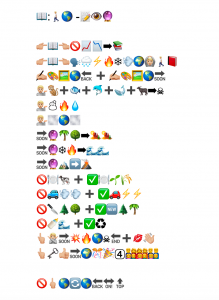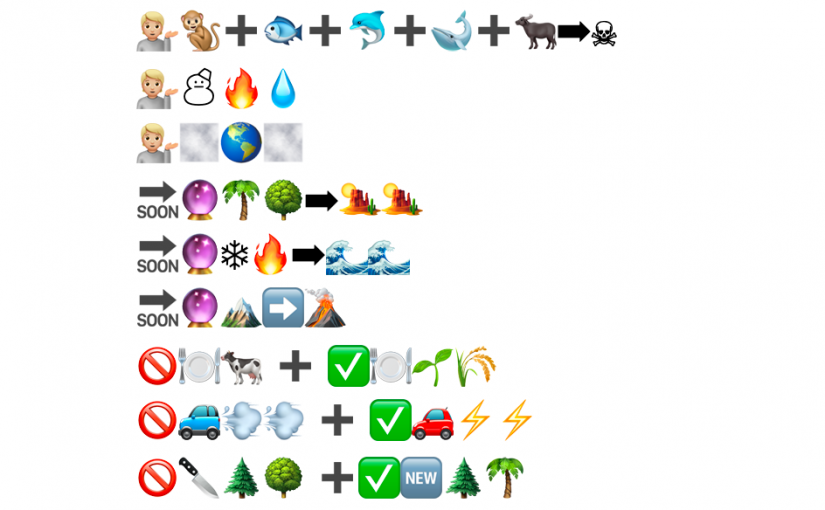
In keeping with some semblance of linearity and order, I did start with the book’s title. Perhaps this was me instinctively appealing to the traditional written word, influencing the reader to follow a strict order of comprehension while needing to interpret word-signifiers (Kress, 2005). This notion may not specifically apply when ‘reading’ emojis. Even still, it became increasingly difficult to keep the sequencing of ideas consistent and transcribe every word itself, or the meaning of a word collection for that matter, into strict hieroglyphic-type structures. Before attempting the emoji-transcription, I wrote out what I would have said had I been asked to write a description of the book and its plot. From there, I worked on assigning suitable emojis to express what would have been said through text.
Kress asserts that “words are (relatively) empty entities – in a semiotic account they are signifiers to be filled with meaning rather than signs full of meaning, and the task of the reader is to fill these relatively vacant entities with her or his meaning” (Kress, 2005). Although I do not wholly agree with this characterization of words, I do think it is exceptionally true for this exercise and our interpretation and communication through the use of emoji images. This task was certainly harder than I expected it to be, and I did choose this work based on how much I presumed I would be able to express through image rather than text.
As I reflected on this process, it became clear to me that I was attempting to translate each word into an image; this strategy quickly proved near impossible. I then began to assign an emoji symbol to a number of conceptual ideas, hoping to illustrate a collection of words and meanings with a singular image. This proved to be slightly easier but still exceptionally challenging considering there are a finite amount of emoji symbols; I quickly learned that not every word/ concept has an emoji. I began asking: “Why isn’t there an emoji for this??” (A cannon or for example, or an equal sign!). Moreover, it was difficult to organize ideas and sentences without punctuation; I opted to indicate a new sentence by writing on a new line, evoking the image of the scroll once again. There are a number of emojis that include words in them, such as “soon”, “back”, and “top” and I may have got away with a technicality on using those – Although they are considered emoji symbols, they do have specific text incorporated in them. I also appealed to a number of mathematical symbols and used them as one would use an article in the English language. Funny how there is no equal sign emoji…
It’s clear that at first glance, the meaning of my ‘emoji book review’ is ambiguous and leaves much up to the reader to interpret. I couldn’t help but relate this to the Egyptian hieroglyphs example that Hayles describes as negotiating meaning among several images. No one emoji indicated one word, rather it was a collection of them that produced some approximation of meaning:
Meaning was thus negotiated among several images, and it was their interrelation that determined significance rather than a one-to-one correlation between mark and sound (Hayles, 2003).
Similarly, my emoji synopsis reflects the same type of idea. It is a grouping of images that creates one meaning, word, or sound and those meanings are negotiated by the reader. Different readers may come up with different interpretations, but with that said, I believe the central essence and meaning of the ‘text’ will be maintained. Kress describes a similar idea when dealing with the computer screen as the contemporary canvas: “it is dominated by the logic of image—means that the practices of reading becoming dominant are the practices derived from the engagement with image and/or depiction in which the reader designs the meaning from materials made available on the screen” (Kress, 2005).
To view this notion practically, I look at the Google Doc in which I currently am writing these words and perceive an overwhelming number of symbolic representations, each of which have meaning and purpose in the creation of these words. The “X” means to close a specific window, the “B” is to bold letters, the “paperclip” means to link, etc. I’m sure there are some symbols that many users are simply unsure about and are uncertain about their purpose. Can they assume their meaning based on the icon? Can the same be said about emojis? I think the difference here, however, is that each one of these symbols indicates a specific action in relation to word processing, whereas emojis were not designed to be used to transcribe the written word but rather to primarily express a human emotion.
Hayles, K. (2003). Deeper into the Machine: The Future of Electronic Literature. Culture Machine Vol. 5, online.
Kress (2005). Gains and losses: New forms of texts, knowledge, and learning. Computers and Composition, Vol. 2(1), 5-22

Hi Carlo,
I am going to take a chance here–is the book “The Future Earth” by Eric Holthaus? Even though I have not read the book, I do remember reading about it sometime back.
I agree with your analysis–it is difficult to use an emoji for each word, therefore I like the way you have used a single emoji to convey a collection of meanings.
A close guess Manize – You’re on the right track, but that is not it! I am going to give a few other participants the opportunity to guess before revealing the title.